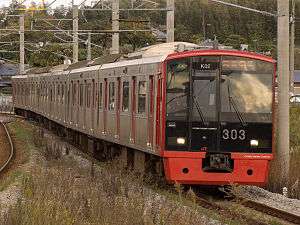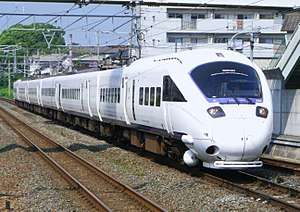303 series
| 303 series | |
|---|---|
 Set K02, November 2009 | |
| In service | January 2000 – present |
| Manufacturer | Kinki Sharyo |
| Constructed | 1999–2002 |
| Number built | 18 vehicles (3 sets) |
| Number in service | 18 vehicles (3 sets) |
| Formation | 6 cars per trainset |
| Fleet numbers | K01–K03 |
| Operator(s) | JR Kyushu |
| Depot(s) | Karatsu |
| Line(s) served | Chikuhi Line, Fukuoka Subway Kuko Line |
| Specifications | |
| Car body construction | Stainless steel |
| Car length | 20,000 mm (65 ft 7 in) |
| Width | 2,800 mm (9 ft 2 in) |
| Height | 4,045 mm (13 ft 3.3 in) |
| Floor height | 1,130 mm (3 ft 8 in) |
| Doors | 4 pairs per side |
| Traction system | IGBT-VVVF |
| Traction motors | MT401K |
| Power output | 150 kW per motor |
| Electric system(s) | 1,500 V DC |
| Current collection method | Overhead catenary |
| Bogies | DT405K, TR405K |
| Safety system(s) | ATC, ATO |
| Track gauge | 1,067 mm (3 ft 6 in) |
The 303 series (303系) is a DC electric multiple unit (EMU) commuter train type operated by Kyushu Railway Company (JR Kyushu) on Chikuhi Line and Fukuoka Subway Kuko Line through-running services in Kyushu, Japan, since 22 January 2000.[1]
Design
The 303 series trains were designed to augment the 103-1500 series EMUs used on the Chikuhi Line, coinciding with double-tracking of the section between Shimoyamato and Chikuzen-Maebaru.[2] The trains have lightweight stainless bodies with painted steel cab ends.[2]
Operations
The 303 series trains are used on through services between Nishi-Karatsu the Chikuhi Line and Fukuokakūkō on the Fukuoka Subway Kuko Line.[3] They are compatible with automatic train operation (ATO) used on the Fukuoka Subway tracks, and are also equipped for wanman driver only operation.[2]
Formations
The fleet consists of three six-car sets, numbered K01 to K03 and based at Karatsu Depot. The sets are formed as shown below with four motored ("M") intermediate cars and non-powered driving trailer ("Tc") cars, with car 1 at the Nishi-Karatsu end.[2][3]
| Car No. | 1 | 2 | 3 | 4 | 5 | 6 |
|---|---|---|---|---|---|---|
| Designation | Tc | M | M' | M | M' | Tc' |
| Numbering | KuHa 303 | MoHa 303-100 | MoHa 302 | MoHa 303 | MoHa 302-100 | Tc' |
| Weight (t) | 28.4 | 33.6 | 32.4 | 32.4 | 32.7 | 26.4 |
| Capacity (total/seated) | 140/45 | 153/51 | 153/51 | 153/51 | 153/51 | 140/45 |
Cars 2 and 5 are each equipped with two PS402K single-arm pantographs.[3]
Interior
Passenger accommodation consists of longitudinal bench seating throughout.[2] Car 1 has a universal access toilet.[3]
 Interior view, July 2010
Interior view, July 2010 The universal-access toilet in car 1, July 2010
The universal-access toilet in car 1, July 2010
History
The trains entered service on 22 January 2000.[3] A toilet was retrofitted to car 1 in each set between 2003 and 2004 at JR Kyushu's Kokura Works.[3]
Build details
The three sets were built by Kinki Sharyo between 1999 and 2002.[3] The fleet build details are as shown below.[3]
| Set No. | Manufacturer | Date delivered | Toilet added |
|---|---|---|---|
| K01 | Kinki Sharyo | 1 December 1999 | 21 October 2003 |
| K02 | Kinki Sharyo | 4 December 1999 | 7 November 2003 |
| K03 | Kinki Sharyo | 28 August 2002 | 30 January 2004 |
References
| Wikimedia Commons has media related to 303 series. |
- ↑ Haraguchi, Takayuki (2009). Encyclopedia of JR's Railway Cars: JR全車両. Japan: Sekai Bunka. p. 67. ISBN 978-4-418-09905-4.
- 1 2 3 4 5 JR全車輌ハンドブック2009 [JR Rolling Stock Handbook 2009]. Japan: Neko Publishing. 2009. pp. 385–386, 637. ISBN 978-4-7770-0836-0.
- 1 2 3 4 5 6 7 8 JR電車編成表 2014夏 [JR EMU Formations - Summer 2014]. Japan: Kotsu Shimbunsha. 30 May 2014. p. 220. ISBN 978-4-330-46614-9.
